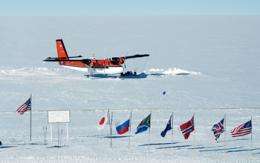US, New Zealand search-and-rescue teams recalled from Antarctic plane crash site

Officials with the U.S. Antarctic Program (USAP) and Antarctica New Zealand have jointly decided to recall search-and-rescue teams from the site of an Antarctic aircraft crash after examination of the plane indicated that it would be unsafe at this point to further disturb the wreckage that is largely embedded in snow and ice on a steep mountain slope.
The team was able to recover some equipment from the exposed tail of the de Havilland DHC-6 Twin Otter, including the cockpit voice recorder, which should provide aviation authorities with more information about the cause of the crash. However, the team was unable to safely access, and so unable to recover, the remains of the crew.
With the advent of the Antarctic winter, and the generally poor weather conditions at the crash site, any renewed effort to recover the remains will need to wait until the next Antarctic research season.
The joint U.S./New Zealand rescue team will return to the National Science Foundation's (NSF) McMurdo Station and Antarctica New Zealand's Scott Base later today.
Officials of the Italian Antarctic Program and Kenn Borek Air Ltd., the Calgary, Canada-based operator of the aircraft, have been advised of the decision to recall the team.
Communication with the Twin Otter was lost on Wednesday night, New Zealand time, and search-and-rescue operations have been hampered by bad weather and poor visibility since that time.
The plane was flying in support of the Italian Antarctic Program under the logistical responsibility of the Italian National Agency for New Technologies, Energy and Sustainable Economic Development (ENEA). The aircraft was enroute from NSF's Amundsen-Scott South Pole Station to the Italian research station at Terra Nova Bay when contact was lost.
The three crew members were the only people aboard the plane at the time.
On the afternoon of Saturday, Jan. 26, local time, a ski-equipped LC-130 aircraft, operated by the New York Air National Guard for the USAP and flying from McMurdo Station, overflew the last known position from the aircraft emergency beacon and spotted the aircraft tail at an elevation of about 3,900 meters (13,000 feet) on Mt. Elizabeth, a 4,480-meter (14,500-foot) summit in the Queen Alexandra Range of the Transantarctic Mountains.
Subsequently, a Twin Otter carrying U.S. and New Zealand search-and-rescue personnel conducted an aerial survey of the site and determined that a landing by fixed-wing aircraft was not possible.
Later, two helicopters—one under New Zealand charter and the other flown for the USAP by PHI, Inc., of Lafayette, Louisiana—arrived at a small camp established roughly 50 kilometers (31 miles) from the crash location to support the operation.
Provided by National Science Foundation


















